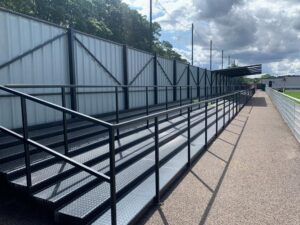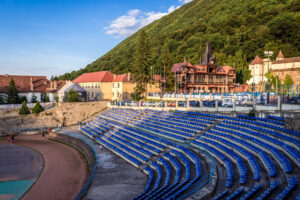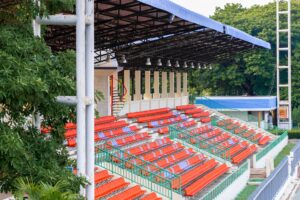In the realm of sports ground development, few factors hold as much sway over the spectator experience as the quality of sightlines. Ensuring that every seat in the house offers an unobstructed view of the action is not merely a matter of convenience; it’s a cornerstone of modern stadium architecture.
This commitment to clear sightlines reflects a deeper understanding of what it means to be a fan: to feel fully immersed in the game, connected to every pass, play, and moment of triumph. It’s about guaranteeing that spectators, regardless of their seating position, can share in the collective thrill of live sports without compromise.
The importance of this design philosophy has only grown as stadiums evolve into multifunctional venues. Today’s spectators expect more than just a view; they seek a complete experience, one that is enriched by the venue’s ability to offer clear and comprehensive sightlines.
From the initial approach and entry into the stadium to the moment the game ends, every aspect of the spectator’s journey is influenced by how well the venue accommodates unobstructed views.
This blog explores the strategies that make this possible, shedding light on the intricate balance between design, technology, and the unyielding passion of the sports enthusiast.
Understanding Sightlines
At its core, the concept of sightlines refers to the direct line of vision from a spectator’s eye to the action on the field, court, or stage. In sports venues, the challenge of maintaining clear sightlines is compounded by the varying activities and scales of play involved.
This challenge necessitates a multifaceted approach, considering factors such as the slope of seating tiers, the height of obstructions, and the distance from the farthest seat to the action.
Effective sightline design ensures that every spectator, from the front row to the last, enjoys a clear, unobstructed view, thereby enhancing the overall experience of attending live events.
The significance of sightlines extends beyond mere visibility. It impacts how spectators perceive the game, influencing their level of engagement and satisfaction.
A well-designed venue takes into account the natural human field of view, optimising seat placement and angles to ensure that the action remains within this visual field without strain or obstruction.
Such considerations are crucial for inclusive design as well, where the aim is to provide equitable viewing experiences for all attendees, including those with disabilities.
As we delve deeper into design principles, the commitment to unobstructed sightlines emerges as a key driver of stadium architecture and planning.

Design Principles for Enhanced Sightlines
Central to the design of any sports venue is the strategic use of tiered seating arrangements. This method not only maximises space but also ensures that spectators’ seats that are further back are elevated above those in front, minimising obstructions and enhancing the view.
The precise angling and spacing of tiers are critical, requiring a delicate balance to provide optimal sightlines without compromising safety or comfort. This design principle reflects a deep understanding of spectator needs, acknowledging that visibility is paramount in creating memorable experiences.
Stadium geometry plays another vital role in sightline optimisation. The curvature of seating areas, the positioning of aisles, and the layout of the venue all contribute to how well spectators can see the action.
Architects must navigate these considerations carefully, often employing sophisticated modelling tools to predict how changes in design will affect visibility from factors such as reflective glare.
By prioritising sightlines in this way, designers can ensure that even the most dynamically shaped venues offer clear views, thereby enhancing spectator enjoyment and engagement.

Innovative Solutions for Sightline Improvement
The evolution of stadium design has seen the introduction of innovative solutions aimed at improving sightlines. Among these, retractable seating offers flexibility, allowing venues to adjust configurations based on the event and its viewing requirements.
This adaptability is key in multi-use venues, where sightline needs can vary dramatically from one event to the next. Similarly, the use of transparent barriers and minimalistic design elements reduces visual obstructions, ensuring that even safety features and essential structures do not impede the view.
Case studies of stadiums around the world provide practical examples of how these solutions have been implemented.
From arenas that have revolutionised the use of space to those that have embraced cutting-edge materials and design approaches, the quest for perfect sightlines has driven remarkable innovations in stadium architecture.
These examples not only serve as inspiration but also as proof of what is possible when the spectator experience is placed at the heart of design.

Technology and Sightlines
The integration of technology has opened new avenues for enhancing spectator sightlines. Digital screens strategically placed around the venue can supplement live views, ensuring that spectators have access to close-ups, replays, and other enriching content.
Augmented reality (AR) takes this a step further, offering personalised, enhanced views through smart devices or AR glasses. These technologies not only improve sightlines but also add depth to the spectator experience, providing insights and information that would otherwise be unavailable.
Apps and in-seat services complement these technological enhancements by offering options for food and merchandise orders, instant replays, and social sharing without requiring spectators to leave their seats or miss crucial moments.
With the evolving role of technology in enhancing the spectator experience, the potential for virtual and augmented reality to revolutionise how we view live sports is immense.
These tools not only promise to overcome the physical limitations of traditional seating but also offer a personalised viewing experience that could redefine fan engagement.
The future of stadium design seems poised on the cusp of a technological revolution, one that will seamlessly blend the physical and digital to provide unprecedented views and experiences for all spectators.
Conclusion
The journey towards maximising spectator sightlines in sports venues is an ongoing pursuit of excellence in design and technology.
As we have explored, the impact of clear, unobstructed views on the spectator experience cannot be overstated.
It’s about more than just seeing the game; it’s about feeling fully immersed in the atmosphere, connected to every moment on the field.
The strategies and innovations discussed herein represent the forefront of this endeavour, illustrating a dedicated effort to enhance the way fans engage with live sports.
In conclusion, the emphasis on sightline optimisation underscores a broader commitment within stadium design to prioritise the needs and experiences of spectators.
As technology continues to evolve and new design philosophies emerge, the focus on delivering an unmatched viewing experience remains paramount.
The future of sports venue design promises even greater innovations, all aimed at ensuring that when it comes to spectator sightlines, every seat in the house is the best seat in the house.

